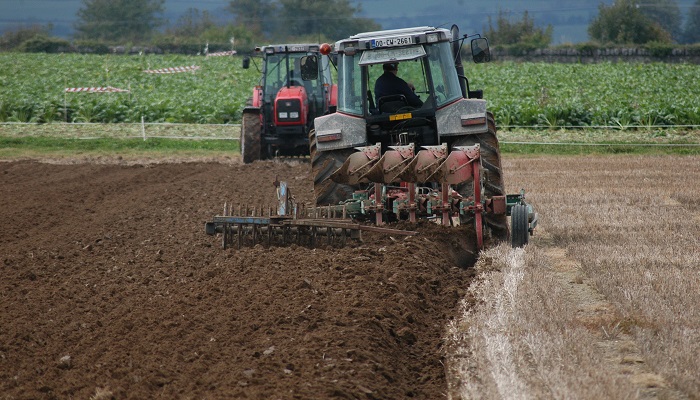05 April 2024
Risk mitigation advice for tillage farms

Challenging ground conditions on account of high levels of rainfall, first occurring at harvest 2023 and persisting through the winter cropping campaign, have continued to pose challenges on tillage farms this spring.
That’s according to Dr Stan Lalor, Teagasc Director of Knowledge Transfer, who briefed the National Fodder and Food Security Committee on Friday, March 29.
The next fortnight will be critical for the establishment of many crops, Dr Lalor explained, while presenting data compiled by Michael Hennessy, Teagasc Head of Crops Knowledge Transfer, given that spring plantings have already been severely curtailed and, at a maximum, just 10-15% of spring plantings have been completed in the driest areas of the country. This, combined with a reduced winter cropping area and some winter crops requiring re-planting, will add pressure on many tillage farms when establishing crops.
On the opportunity to sow crops, Dr Lalor said: “Given current ground conditions, a minimum of one week of dry weather is needed before planting. On heavier soils, this could be pushed out by two weeks, while land where late-harvested crops – such as maize, beet or potatoes – had been sown will also take longer to become workable. Under the best case scenario, we’re looking at mid-April plantings.”
Cropping options and impact of late planting
Given the above, he also delved into the cropping options available, confirming that it is now too late to establish winter wheat, while the window of opportunity for establishing crops such as spring wheat, beans and spring oats is also closing. Ideally, these crops should be sown by mid-March, but there may still be an opportunity to plant where spring barley seed supplies are tight.
Describing the sowing dates for which crops would be considered as late, he noted that crops of spring wheat, beans and spring oats sown after early April would be considered late, after mid-April would be considered late for beet, while spring barley, spring oilseed rape and peas can be established up until late April before being classified as being late-sown crops.
Commenting on the impact of late planting, Dr Lalor said: “Crops sown after mid-April are at higher risk of lower yield and require perfect growing conditions after sowing to attain a reasonable yield. Along with this, the harvest window tends to be later, bringing risks when it comes to saving these crops.
“Under normal growing conditions for later-sown crops, yields of 3-3.5t/ha would be expected for spring beans, 5.5-6.5t/ha for spring wheat and 5-6t/ha for spring oats.
“Based on previous years, late-sown crops can be badly impacted where planting is followed by a short or moderate drought in May or June, and can result in reduction in yield of up to 3-4t/ha in cereals.”
Dr Lalor also noted that on account of a reduction in the winter cropping area and a delay in spring crop establishments, harvest timings could be pushed later, meaning there will be less winter crops to cut early and the slower ripening of spring crops, thus creating the risk of a higher proportion of the harvest running into September.
Providing risk mitigation advice to tillage farmers, Dr Lalor highlighted the below:
- Planting spring wheat, spring oats and beans should be considered for as long as possible to maximise overall tillage area
- Not planting these crops will put pressure on spring barley seed availability;
- Late-planted spring wheat could be considered for whole crop silage if a suitable client is available;
- Keeping break crops (beans and oats) in the rotation is important;
- Opportunity to sell forage crops to neighbours, with a contract in place before planting.
- Examine the crop margin, not just yield, carefully
- Avail of fixed price offers where available (e.g. beans – may offer value compared to the falling grain prices);
- Direct payments such as the Protein Payment (~ €350-600/ha) and the Straw Incorporation Measure (€150-250/ha) will be an important part of the income;
- Contact your usual straw customers and look for a solid commitment and an agreed price for straw purchases in 2024.
- Assess ground in the coming days as to the real potential for this land to dry out
- Consider harvest date as well as likely window for planting.
- Crop diversity will allow a spread in planting dates, fertiliser/spraying, and harvesting. Consider the following:
- Relying on just one or two crops over a very large area can increase workloads for critical jobs (unsustainable for equipment or operator);
- Later-planted crops will be harvested later (into September), decreasing the number and length of harvest days and substantially increasing the risk of harvest loses;
- Consider planning a crop type area around realistic combining rates.
- Impact of drought if it follows this prolonged wet spell
- Complete cultivations when the soil conditions are suitable. But reduce the chances of the soil drying out too quickly;
- Press or roll the soil as soon as possible after ploughing / primary cultivation;
- Where ploughing and one-passing – endeavour to roll the seed bed as quickly as possible.
- Other alternatives such as red clover (scheme available) or summer cover crops could be an option.
Also read: Advisory messages from the National Fodder and Food Security Committee meeting
Also read: Time to reset and plan again
More on the National Fodder and Food Security Committee
